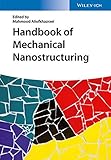Handbook of mechanical nanostructuring / edited by Mahmood Aliofkhazraei.
Material type: TextPublisher: Weinheim, Germany : Wiley-VCH Verlag GmbH & Co. KGaA, 2015Edition: First editionDescription: 1 online resource (2 volumes (xxxii, 750 pages) :) : illustrations (some colourContent type:
TextPublisher: Weinheim, Germany : Wiley-VCH Verlag GmbH & Co. KGaA, 2015Edition: First editionDescription: 1 online resource (2 volumes (xxxii, 750 pages) :) : illustrations (some colourContent type: - text
- computer
- online resource
- 9783527674978
- 3527674977
- 9783527674947
- 3527674942
- 9783527674961
- 3527674969
- 9783527674954
- 3527674950
- 620.115 23
- TA418.9.N35 H365 2015
Includes bibliographical references and index.
Print version record.
Cover; Contents; List of Contributors; Preface; Volume 1; Part I Mechanical Properties of Nanostructured Materials; Chapter 1 Mechanical Properties of Nanocrystalline Materials; 1.1 Introduction; 1.2 Static Properties; 1.2.1 Tensile Behavior; 1.2.2 Nanoindentation; 1.3 Wear Properties; 1.4 Fatigue Properties; 1.5 Crack Behavior; 1.6 Conclusions; References; Chapter 2 Superior Mechanical Properties of Nanostructured Light Metallic Materials and Their Innovation Potential; 2.1 Introduction; 2.2 Nanostructuring of Light Metallic Materials Using SPD Methods.
2.3 Superior Mechanical Strength of NS Light Metals and Alloys2.4 Fatigue Behavior of NS Light Metals; 2.5 Innovation Potential and Application of the NS Light Metals and Alloys; 2.6 Conclusions; Acknowledgments; References; Chapter 3 Understanding the Mechanical Properties of Nanostructured Bainite; 3.1 Introduction; 3.2 NANOBAIN: Significant Extension of the Bainite Transformation Theory; 3.2.1 Bainite Phase Transformation Thermodynamic Theory: Relevant Design Parameters; 3.3 Microstructural Characterization of Nanostructured Bainitic Steels.
3.4 Understanding the Advanced Bainitic Steel Mechanical Properties3.4.1 Strength; 3.4.2 Ductility; 3.4.3 Toughness; 3.5 Summary; Acknowledgments; References; Chapter 4 Inherent Strength of Nano-Polycrystalline Materials; 4.1 Introduction; 4.2 High-field Tensile Testing; 4.3 Tensile Strength of Nanosized Monocrystals; 4.4 Inherent Strength of Bicrystals; 4.5 Conclusions; References; Chapter 5 State-of-the-Art Optical Microscopy and AFM-Based Property Measurement of Nanostructure Materials; 5.1 Introduction; 5.1.1 Optical Microscopy; 5.1.2 Near-Field Scanning Optical Microscopy.
5.1.3 Atomic Force Microscopy5.2 Applications of Optical Microscopy and AFM; 5.2.1 Applications of Optical Microscopy; 5.2.2 Applications of Atomic Force Microscopy; 5.3 New Developments of Optical Microscopy and AFM Techniques; 5.3.1 Optical Microscopy-Based 3D Shape Reconstruction; 5.3.1.1 Defocus Imaging Model; 5.3.1.2 New Shape Reconstruction Method; 5.3.1.3 Experimental Results; 5.3.2 AFM Based Elasticity Imaging and Height Compensation Method; 5.3.2.1 Compression Effect; 5.3.2.2 Surface Characteristics Measurement; 5.3.2.3 Experiments with MWCNTs and Graphenes; 5.4 Conclusion.
The nanostructuring of materials is a versatile route particularly well-suited to the fabrication of metallic materials for engineering applications with desired properties, for example, increased corrosion and temperature resistance, enhanced performance under mechanical loads or the long-term shape preservation of workpieces. This ready reference provides in-depth information on both the bottom-up and the top-down approaches to the synthesis and processing of nanostructured materials. The focus is on advanced methods of mechanical nanostructuring, such as severe plastic deformation, includin.
John Wiley and Sons Wiley Online Library All Obooks
Computer Science and Engineering
